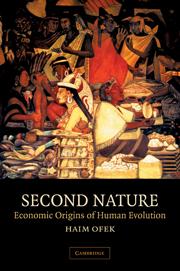Book contents
- Frontmatter
- Contents
- Acknowledgments
- 1 Introduction
- Part 1 Bioeconomics
- Part 2 Paleoeconomics
- 8 Departure from the feed-as-you-go strategy
- 9 The origins of market exchange
- 10 Domestication of fire in relation to market exchange
- 11 The Upper Paleolithic and other creative explosions
- 12 Transition to agriculture: the limiting factor
- 13 Transition to agriculture: the facilitating factor
- References
- Index
12 - Transition to agriculture: the limiting factor
Published online by Cambridge University Press: 06 July 2010
- Frontmatter
- Contents
- Acknowledgments
- 1 Introduction
- Part 1 Bioeconomics
- Part 2 Paleoeconomics
- 8 Departure from the feed-as-you-go strategy
- 9 The origins of market exchange
- 10 Domestication of fire in relation to market exchange
- 11 The Upper Paleolithic and other creative explosions
- 12 Transition to agriculture: the limiting factor
- 13 Transition to agriculture: the facilitating factor
- References
- Index
Summary
Against all odds, agriculture was not part of the “creative explosion.” The Upper Paleolithic people, completely obsessed with wildlife – especially with grazing animals (as evident, for instance, from their art) – strangely enough found no interest in domesticating any of them. Food production would have been, it seems, the logical conclusion of the Middle to Upper Paleolithic transition, yet for no immediately apparent reason it was never attempted. This failure to act defied for a long time any explanation, although such an explanation is key to any attempt to understand the transition to agriculture, if not to civilization itself.
In 1993 a promising clue was discovered in unexpected quarters. Of all places, it was extracted from a deep hole in the ice-cap over a remote mountaintop thousands of miles away from the nearest site that could conceivably have served as a cradle of early agriculture. It came in the form of a three-page report published that year in Nature (364: 218–220) by a group of scientists from the Ice-core Project Summit (GRIP) of Greenland (a country with a land area 99% unfit for agriculture). I will come back to this report shortly, but first we have to establish the necessary environmental and economic connections.
Five unexplained remarkable facts
The first humans who relied on agriculture left more traces in the archaeological record than any culture that preceded them; so much so, that they are a mystery to us primarily because of what we know about them, rather than what we don't.
- Type
- Chapter
- Information
- Second NatureEconomic Origins of Human Evolution, pp. 190 - 211Publisher: Cambridge University PressPrint publication year: 2001

